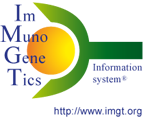Frequently asked questions
IMGT/3Dstructure-DB
- When atomic contacts are displayed in IMGT/3Dstructure-DB between peptide and MHC or between TR and pMHC, are they as stated in the original papers or are they derived data from an IMGT algorithmic analysis on the structural information?
- How are the contacts differentiated between what is actually described in the original papers and the ones that are results of the IMGT analysis?
- What is the difference between the peptide interactions (with MHC) displayed via the peptide amino acid "IMGT Residue@Position cards" and through the IMGT Collier de Perles with "IMGT pMHC contact sites" (i.e the list of C1 to C11 contact sites)?
- When there are two crystallographic complexes then is the contacts analysis based on one set of chains (i.e one single complex)? How did you handle these situations and is there a caution of some kind to be aware of?
- Are only V-region alleles that are "F", "(F) " or "[F]" assigned to proteins in IMGT/3Dstructure-DB?
- How to display the genes and alleles names of the individual chains?
